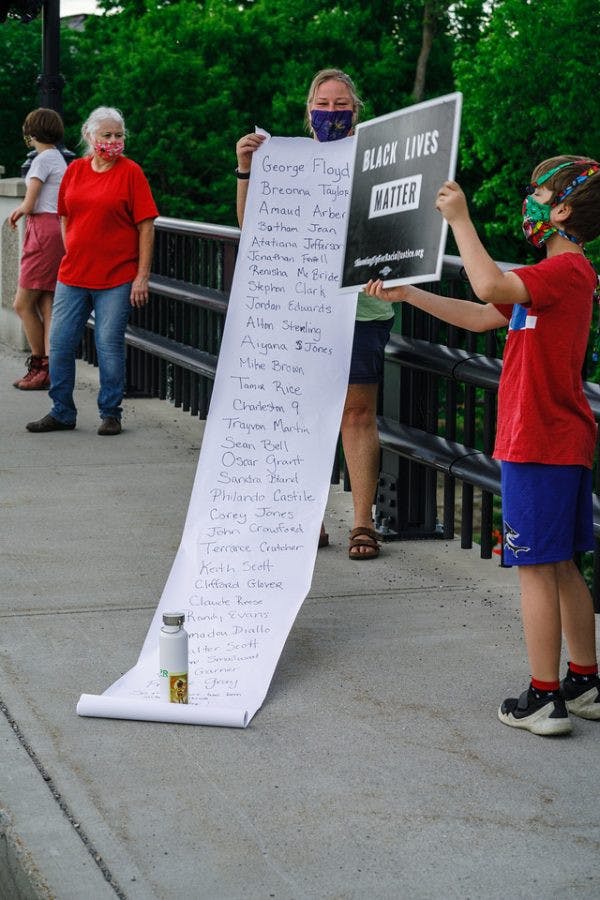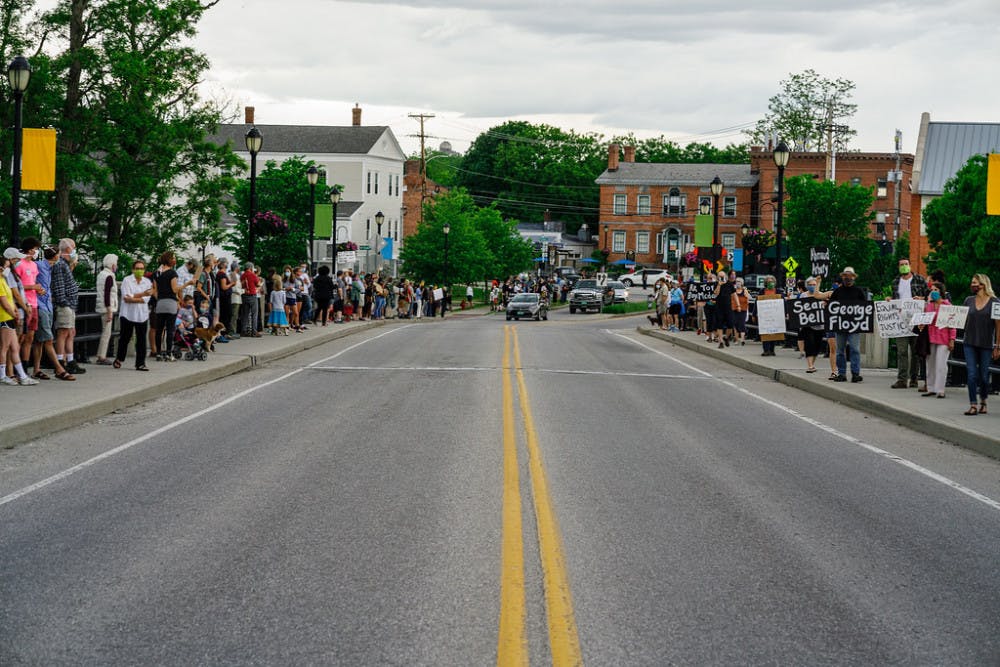As thousands around the world protested this weekend against the killing of George Floyd by a Minneapolis police officer, the town of Middlebury joined in a collective vigil for Floyd’s life.
Roughly 375 people congregated — while maintaining social distance and wearing masks — on and around College Park and the Cross Street Bridge on Saturday to remember Floyd and to protest the act of police brutality that ended his life.
The Middlebury chapter of Showing Up For Racial Justice (SURJ) and the Champlain Valley Unitarian Universalist Society (CVUUS) organized the vigil. Due to Middlebury’s rural location and the threats presented by the Covid-19 outbreak, organizers were careful to consider the risk of Covid-19 spread in setting up the event. Organizers planned the event to occur in tandem with a protest held in Burlington, and participants were asked to limit chanting and yelling during the demonstration in order to combat the transmission of the novel coronavirus.
“We were all wearing masks and standing far apart. There was something powerful to me about that. Normally rallies and protests have some element of socializing to them, as we greet friends and neighbors we haven’t seen in a while,” Professor Pam Berenbaum, director of Middlebury’s global health program, said in an email to The Campus. “This time, it felt quieter and more somber, as people were aware of the risks of attending a public event during Covid-19 and kept the greetings to a minimum. As a result, the issue we were protesting, racial injustice, seemed to come into sharper relief.”
Joanna Colwell, media and outreach coordinator for SURJ Middlebury, sees a connection between Covid-19 prevention measures and the vigil itself. “Both embody a sort of caring for your community,” Colwell said. “Wearing a mask is a way to say that I care about your safety.”
The result was a somber and reflective demonstration, a far cry from the violence and rioting that has beset many American cities in the last week. Participants remained on the sidewalk and there was no visible Middlebury Police Department presence. This too was a contrast from similar demonstrations around the country, where protesters marching in streets faced widespread police brutality.

In Middlebury, the demonstration remained calm. Participants held signs of the names of unarmed black men and women who had been killed by police around the country. Families used the opportunity to teach their young about the harsh realities of the country, said Economics Professor Jon Isham.
Isham was at first taken aback by the vigil’s non-traditional form, a result of the organizers’ Covid-19 prevention efforts. “It was very respectful and very somber,” he said. “Everyone was looking for what to do, looking down the road, looking for an answer.”
Echoing a sentiment shared by President Patton in her statement on Floyd’s killing, Isham pointed to the consciousness of Covid-19 transmission as illustrating the country’s battle against what he described as two pandemics, the virus and racism.
Yet, organizers acknowledged that in order for the demonstration to be truly meaningful, work must continue through the summer and beyond. Throughout the demonstration, SURJ handed out flyers with information on resources and actions to continue anti-racist work after the event, including links to bail funds and petitions.

“Our vigil nourished my faith that Addison County is well situated to be a bright light in the struggle to dismantle racism,” said Reverend Barnaby Feder, minister of CVUUS. “But it didn't undermine the systems and attitudes that make events like the murder of George Floyd inevitable. That is the real work still to be done."
Colwell was even blunter, referencing Addison County’s overwhelmingly white population. “As white people in a racist society, we think it’s ‘those bad racist people’ over there, but that is untrue. We need to make sure that people continue to do the work after the moment passes.”
The town and college have not escaped incidents of police discrimination and brutality in the past, with Middlebury Public Safety’s history of racial profiling allegations and Vermont’s rise in deaths at the hands of police anchoring the issues in Addison County.
Colwell and Feder had originally planned for around 100 participants to arrive on Saturday. They were happily surprised when close to 400 protesters showed up. For Colwell, the purpose of both the vigil and its Covid-19 prevention measures boil down to a simple sentiment: “everyone deserves to be safe.”

Jake Gaughan is an Editor at Large.
He previously served as an Opinion Editor and News Editor.




